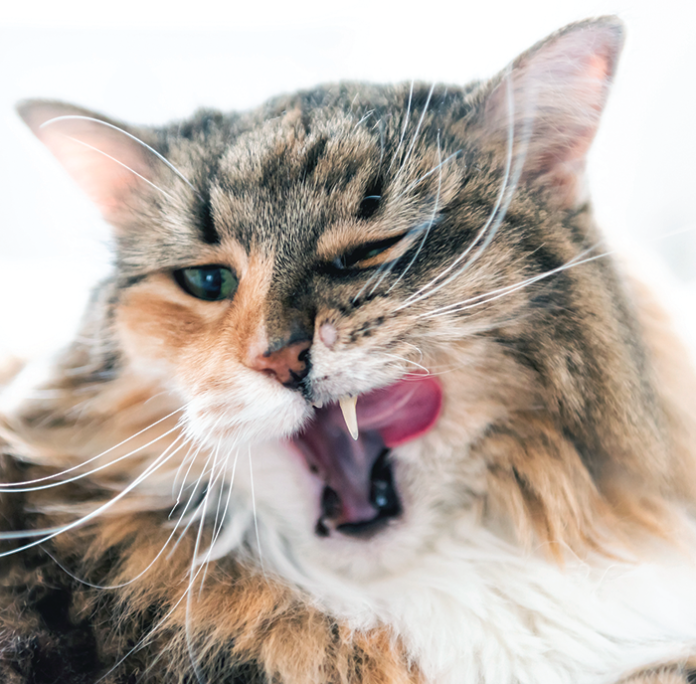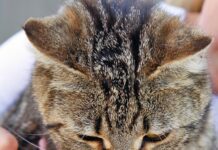When a person loses all their teeth, major lifestyle changes, such as dentures and diet adjustments, are usually necessary. Luckily, cats adapt more easily. They can commonly still meow and hiss and eat normally once they heal from the extraction surgery.
Cats who need full dental extraction or lose many teeth usually suffer from one of two dental problems: feline odontoclastic resorptive lesions (FORL) or gingivitis/stomatitis.
Tooth Resorption
Tooth resorption is common in cats, especially cats over 5 years old. Estimates are that 20 to 60 percent of all cats will suffer from some tooth resorption. It might be one or two teeth, or it might be a mouthful. Owners may notice their cat chewing strangely, with her head tilted, trying to chew on just one side of her mouth, or avoiding dry food to preferentially eat canned food. Alternatively, you might realize your cat is swallowing her kibble without attempting to chew it.
Diagnosing FORL requires an oral exam with special dental radiographs. The cat will need sedation and/or anesthesia. Initially, root resorption will not be especially painful but, as the surrounding gums and possibly the nerves in the center of the tooth pulp become involved, these teeth will become painful. Your veterinarian usually will suggest removing teeth showing signs of FORL. Depending on the tooth, removal may leave an open area of gum to heal, or the gum may be sutured.
Gingivitis/Stomatitis
Gingivitis/stomatitis means inflammation of the gum (gingivitis) or the whole mouth (stomatitis). Lymphocytic plasmacytic gingivitis/stomatitis (LPGS) is the most severe form of this condition.
Why cats get LPGS is not clear. They may be hypersensitive to the bacteria and plaque that accumulate with dental disease. Immune-mediated diseases are also a possible cause. Calicivirus and herpesvirus infections have been implicated, with up to 88% of cats with stomatitis shedding these viruses.
For some breeds, a genetic predisposition may be to blame. Siamese, Himalayans, Somalis, and Persians are somewhat predisposed, and signs may show up in them as early as 6 months to a year of age.
Cats with stomatitis may drool, paw at their mouths, and may approach their food bowl but then back away without eating. You might notice your cat hiding (a nonspecific reaction to pain) or having bad breath. The tissues of the mouth can become inflamed, ulcerated, and painful.
Diagnosis will require sedation or general anesthesia to facilitate a full oral examination and dental radiographs. This diagnostic phase often continues directly into treatment, with a dental cleaning and removal of affected teeth.
A thorough cleaning and a dose of antibiotics combined with anti-inflammatory medication may help initially. Bovine lactoferrin, which is a bactericidal immune-modulating substance, can help, since it seems to inhibit plaque and bacteria from adhering to the oral surfaces. Dedicated home care may stave off relapses but is most successful if cases are caught early and the cat is cooperative about brushing.
The Extraction
Eventually, many cats need their teeth removed. Full dental extractions clear about 60% of feline stomatitis cases. Follow-up laser therapy can encourage healing. Once these cats have healed, they can easily eat soft food and many even eat their favorite kibble.
“Full mouth extraction is well tolerated by cats, but their recovery depends on the nature of the disease that necessitated the procedure to be performed. For example, cats suffering from advanced periodontitis or extensive tooth resorption are likely to recover more quickly than cats who receive complete dental extraction to manage chronic gingivostomatitis,” says Eric M. Davis, DVM, Dipl. AVDC (Cornell 1979), a board-certified veterinary dentist.
During healing, it is important to provide soft, easy-to-eat foods. Keeping both food and water at room temperature also encourages cats to eat and drink initially. The gums and palate harden and toughen up after healing. Many cats, however, want to transition back to their earlier diet, even if that is dry kibble.
“Cats do need some time to learn how to manipulate their tongue and cheeks to direct food toward the back of their mouth to be swallowed. The presence of teeth forms a channel to keep food in the center aspect of the mouth. Without teeth, food can end up in the sides of the mouth, and that requires the cat to figure out how to direct the food backward.
“We usually recommend that cats continue to be fed their usual diet postoperatively, but with water added to soften the food. A dietary change postoperatively can result in digestive upset. Cats do not chew dry food. The particles are almost always swallowed whole. Therefore, cats that prefer dry food can continue to be fed kibble even without teeth,” says Dr. Davis.
While no one wants their kitty to lose her teeth, cats usually recover from dental extractions well and return to their normal lives, eating their regular food once healing is complete.
Odontoclasts Gone Wild
An odontoclast is a cell whose function is to resorb bone. In a healthy cat, these cells help with removal of deciduous teeth. In cats with FORL, however, the cells attack the roots of permanent teeth as well.
Myth Busting
The belief that excess vitamin D causes tooth loss was fueled by one study that showed about one third of all cat foods had excessive amounts of vitamin D. However, further studies have discounted this theory.




